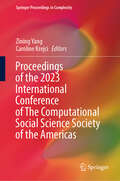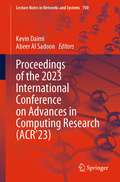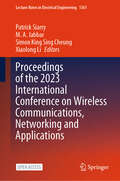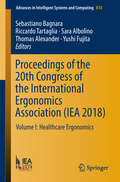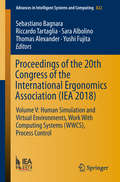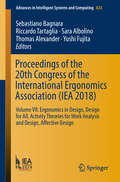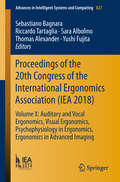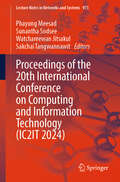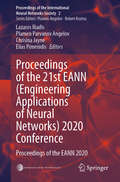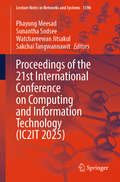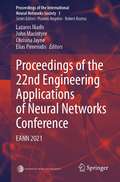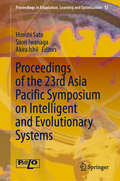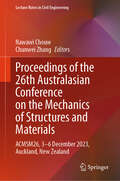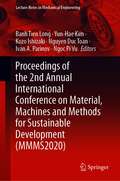- Table View
- List View
Proceedings of the 2023 International Conference of The Computational Social Science Society of the Americas (Springer Proceedings in Complexity)
by Zining Yang Caroline KrejciThis book contains a selection of the latest research in the field of Computational Social Science (CSS) methods, uses, and results, as presented at the 2023 annual conference of the Computational Social Science Society of the Americas (CSSSA). This conference is held in Santa Fe, New Mexico, November 2–5, 2023. CSS is the science that investigates social and behavioral dynamics through social simulation, social network analysis, and social media analysis. The CSSSA is a professional society that aims to advance the field of computational social science in all areas, including basic and applied orientations, by holding conferences and workshops, promoting standards of scientific excellence in research and teaching, and publishing research findings and results.
Proceedings of the 2023 International Conference on Advances in Computing Research (Lecture Notes in Networks and Systems #700)
by Kevin Daimi Abeer Al SadoonThis book includes recent research on Data Science, IoT, Smart Cities and Smart Energy, Health Informatics, and Network Security. The International Conference on Advances in Computing Research (ACR’23) brings together a diverse group of researchers from all over the world with the intent of fostering collaboration and dissemination of the advances in computing technologies. The conference is aptly segmented into six tracks to promote a birds-of-the-same-feather congregation and maximize participation. The first track covers computational intelligence, which include, among others, research topics on artificial intelligence, knowledge representation and management, application and theory of neural systems, fuzzy and expert systems, and genetic algorithms. The second track focuses on cybersecurity engineering. It includes pertinent topics such as incident response, hardware and network security, digital biometrics and forensics technologies, and cybersecurity metrics and assessment. Further, it features emerging security technologies and high-tech systems security. The third track includes studies on data analytics. It covers topics such as data management, statistical and deep analytics, semantics and time series analytics, and a multitude of important applications of data analytics in areas such as engineering, health care, business, and manufacturing. The fourth track on network and communications covers a wide range of topics in both areas including protocols and operations, ubiquitous networks, ad hoc and sensor networks, cellular systems, virtual and augmented reality streaming, information centric networks, and the emerging areas in connected and autonomous vehicle communications. Lastly, the final track on cloud and mobile computing includes areas of interest in cloud computing such as infrastructure, service, management and operations, architecture, and interoperability and federation. This track also includes important topics in mobile computing such as services and applications, communication architectures, positioning and tracking technologies, the general applications of mobile computing.
Proceedings of the 2023 International Conference on Wireless Communications, Networking and Applications (Lecture Notes in Electrical Engineering #1361)
by Patrick Siarry Xiaolong Li M. A. Jabbar Simon King Sing CheungThis open access book includes original, peer-reviewed research papers from the 2023 International Conference on Wireless Communications, Networking and Applications (WCNA 2023), held in Shenzhen, Guangdong, China, from December 29 to 31, 2023. The topics covered include but are not limited to: Wireless Communications; Devices, Tools, and Techniques for WSN and Other Wireless Networks; Wireless Sensor Networks; Internet of Things (IoT); AI; Signal Processing; and Sustainable Pervasive WSN Applications. The papers showcased here share the latest findings on Wireless Communications, Networking and Applications, making the book a valuable asset for researchers, scientists, scholars, engineers and students from the universities all around the world and the industry.
Proceedings of the 20th Congress of the International Ergonomics Association: Volume I: Healthcare Ergonomics (Advances in Intelligent Systems and Computing #818)
by Thomas Alexander Sebastiano Bagnara Riccardo Tartaglia Sara Albolino Yushi FujitaThis book presents the proceedings of the 20th Congress of the International Ergonomics Association (IEA 2018), held on August 26-30, 2018, in Florence, Italy. By highlighting the latest theories and models, as well as cutting-edge technologies and applications, and by combining findings from a range of disciplines including engineering, design, robotics, healthcare, management, computer science, human biology and behavioral science, it provides researchers and practitioners alike with a comprehensive, timely guide on human factors and ergonomics. It also offers an excellent source of innovative ideas to stimulate future discussions and developments aimed at applying knowledge and techniques to optimize system performance, while at the same time promoting the health, safety and wellbeing of individuals. The proceedings include papers from researchers and practitioners, scientists and physicians, institutional leaders, managers and policy makers that contribute to constructing the Human Factors and Ergonomics approach across a variety of methodologies, domains and productive sectors. This volume includes papers addressing Healthcare Ergonomics.
Proceedings of the 20th Congress of the International Ergonomics Association: Volume II: Safety and Health, Slips, Trips and Falls (Advances in Intelligent Systems and Computing #819)
by Thomas Alexander Sebastiano Bagnara Riccardo Tartaglia Sara Albolino Yushi FujitaThis book presents the proceedings of the 20th Congress of the International Ergonomics Association (IEA 2018), held on August 26-30, 2018, in Florence, Italy. By highlighting the latest theories and models, as well as cutting-edge technologies and applications, and by combining findings from a range of disciplines including engineering, design, robotics, healthcare, management, computer science, human biology and behavioral science, it provides researchers and practitioners alike with a comprehensive, timely guide on human factors and ergonomics. It also offers an excellent source of innovative ideas to stimulate future discussions and developments aimed at applying knowledge and techniques to optimize system performance, while at the same time promoting the health, safety and wellbeing of individuals. The proceedings include papers from researchers and practitioners, scientists and physicians, institutional leaders, managers and policy makers that contribute to constructing the Human Factors and Ergonomics approach across a variety of methodologies, domains and productive sectors. This volume includes papers addressing the following topics: Safety and Health, and Slips, Trips and Falls.
Proceedings of the 20th Congress of the International Ergonomics Association: Volume III: Musculoskeletal Disorders (Advances in Intelligent Systems and Computing #820)
by Thomas Alexander Sebastiano Bagnara Riccardo Tartaglia Sara Albolino Yushi FujitaThis book presents the proceedings of the 20th Congress of the International Ergonomics Association (IEA 2018), held on August 26-30, 2018, in Florence, Italy. By highlighting the latest theories and models, as well as cutting-edge technologies and applications, and by combining findings from a range of disciplines including engineering, design, robotics, healthcare, management, computer science, human biology and behavioral science, it provides researchers and practitioners alike with a comprehensive, timely guide on human factors and ergonomics. It also offers an excellent source of innovative ideas to stimulate future discussions and developments aimed at applying knowledge and techniques to optimize system performance, while at the same time promoting the health, safety and wellbeing of individuals. The proceedings include papers from researchers and practitioners, scientists and physicians, institutional leaders, managers and policy makers that contribute to constructing the Human Factors and Ergonomics approach across a variety of methodologies, domains and productive sectors. This volume includes papers addressing Musculoskeletal Disorders.
Proceedings of the 20th Congress of the International Ergonomics Association: Volume IV: Organizational Design and Management (ODAM), Professional Affairs, Forensic (Advances in Intelligent Systems and Computing #821)
by Thomas Alexander Sebastiano Bagnara Riccardo Tartaglia Sara Albolino Yushi FujitaThis book presents the proceedings of the 20th Congress of the International Ergonomics Association (IEA 2018), held on August 26-30, 2018, in Florence, Italy. By highlighting the latest theories and models, as well as cutting-edge technologies and applications, and by combining findings from a range of disciplines including engineering, design, robotics, healthcare, management, computer science, human biology and behavioral science, it provides researchers and practitioners alike with a comprehensive, timely guide on human factors and ergonomics. It also offers an excellent source of innovative ideas to stimulate future discussions and developments aimed at applying knowledge and techniques to optimize system performance, while at the same time promoting the health, safety and wellbeing of individuals. The proceedings include papers from researchers and practitioners, scientists and physicians, institutional leaders, managers and policy makers that contribute to constructing the Human Factors and Ergonomics approach across a variety of methodologies, domains and productive sectors. This volume includes papers addressing Organizational Design and Management.
Proceedings of the 20th Congress of the International Ergonomics Association: Volume IX: Aging, Gender and Work, Anthropometry, Ergonomics for Children and Educational Environments (Advances in Intelligent Systems and Computing #826)
by Thomas Alexander Sebastiano Bagnara Riccardo Tartaglia Sara Albolino Yushi FujitaThis book presents the proceedings of the 20th Congress of the International Ergonomics Association (IEA 2018), held on August 26-30, 2018, in Florence, Italy. By highlighting the latest theories and models, as well as cutting-edge technologies and applications, and by combining findings from a range of disciplines including engineering, design, robotics, healthcare, management, computer science, human biology and behavioral science, it provides researchers and practitioners alike with a comprehensive, timely guide on human factors and ergonomics. It also offers an excellent source of innovative ideas to stimulate future discussions and developments aimed at applying knowledge and techniques to optimize system performance, while at the same time promoting the health, safety and wellbeing of individuals. The proceedings include papers from researchers and practitioners, scientists and physicians, institutional leaders, managers and policy makers that contribute to constructing the Human Factors and Ergonomics approach across a variety of methodologies, domains and productive sectors. This volume includes papers addressing the following topics: Aging, Gender and Work, Anthropometry, and Ergonomics for Children and Education.
Proceedings of the 20th Congress of the International Ergonomics Association: Volume VI: Transport Ergonomics and Human Factors (TEHF), Aerospace Human Factors and Ergonomics (Advances in Intelligent Systems and Computing #823)
by Thomas Alexander Sebastiano Bagnara Riccardo Tartaglia Sara Albolino Yushi FujitaThis book presents the proceedings of the 20th Congress of the International Ergonomics Association (IEA 2018), held on August 26-30, 2018, in Florence, Italy. By highlighting the latest theories and models, as well as cutting-edge technologies and applications, and by combining findings from a range of disciplines including engineering, design, robotics, healthcare, management, computer science, human biology and behavioral science, it provides researchers and practitioners alike with a comprehensive, timely guide on human factors and ergonomics. It also offers an excellent source of innovative ideas to stimulate future discussions and developments aimed at applying knowledge and techniques to optimize system performance, while at the same time promoting the health, safety and wellbeing of individuals. The proceedings include papers from researchers and practitioners, scientists and physicians, institutional leaders, managers and policy makers that contribute to constructing the Human Factors and Ergonomics approach across a variety of methodologies, domains and productive sectors. This volume includes papers addressing the following topics: Transport Ergonomics and Human Factors (TEHF), and Aerospace Human Factors and Ergonomics.
Proceedings of the 20th Congress of the International Ergonomics Association: Volume X: Auditory And Vocal Ergonomics; Visual Ergonomics; Psychophysiology; Ergonomics In Advanced Imaging (Advances In Intelligent Systems and Computing #827)
by Thomas Alexander Sebastiano Bagnara Riccardo Tartaglia Sara Albolino Yushi FujitaThis book presents the proceedings of the 20th Congress of the International Ergonomics Association (IEA 2018), held on August 26-30, 2018, in Florence, Italy. By highlighting the latest theories and models, as well as cutting-edge technologies and applications, and by combining findings from a range of disciplines including engineering, design, robotics, healthcare, management, computer science, human biology and behavioral science, it provides researchers and practitioners alike with a comprehensive, timely guide on human factors and ergonomics. It also offers an excellent source of innovative ideas to stimulate future discussions and developments aimed at applying knowledge and techniques to optimize system performance, while at the same time promoting the health, safety and wellbeing of individuals. The proceedings include papers from researchers and practitioners, scientists and physicians, institutional leaders, managers and policy makers that contribute to constructing the Human Factors and Ergonomics approach across a variety of methodologies, domains and productive sectors. This volume includes papers addressing the following topics: Human Simulation and Virtual Environments, Work With Computing Systems (WWCS), and Process Control.
Proceedings of the 20th Congress of the International Ergonomics Association: Volume X: Auditory And Vocal Ergonomics; Visual Ergonomics; Psychophysiology; Ergonomics In Advanced Imaging (Advances In Intelligent Systems and Computing #827)
by Thomas Alexander Sebastiano Bagnara Riccardo Tartaglia Sara Albolino Yushi FujitaThis book presents the proceedings of the 20th Congress of the International Ergonomics Association (IEA 2018), held on August 26-30, 2018, in Florence, Italy. By highlighting the latest theories and models, as well as cutting-edge technologies and applications, and by combining findings from a range of disciplines including engineering, design, robotics, healthcare, management, computer science, human biology and behavioral science, it provides researchers and practitioners alike with a comprehensive, timely guide on human factors and ergonomics. It also offers an excellent source of innovative ideas to stimulate future discussions and developments aimed at applying knowledge and techniques to optimize system performance, while at the same time promoting the health, safety and wellbeing of individuals. The proceedings include papers from researchers and practitioners, scientists and physicians, institutional leaders, managers and policy makers that contribute to constructing the Human Factors and Ergonomics approach across a variety of methodologies, domains and productive sectors. This volume includes papers addressing the following topics: Ergonomics in Manufacturing, Agriculture, Building and Construction, and Mining, and Human Factors and Sustainable Development.
Proceedings of the 20th Congress of the International Ergonomics Association: Volume X: Auditory And Vocal Ergonomics; Visual Ergonomics; Psychophysiology; Ergonomics In Advanced Imaging (Advances In Intelligent Systems and Computing #827)
by Thomas Alexander Sebastiano Bagnara Riccardo Tartaglia Sara Albolino Yushi FujitaThis book presents the proceedings of the 20th Congress of the International Ergonomics Association (IEA 2018), held on August 26-30, 2018, in Florence, Italy. By highlighting the latest theories and models, as well as cutting-edge technologies and applications, and by combining findings from a range of disciplines including engineering, design, robotics, healthcare, management, computer science, human biology and behavioral science, it provides researchers and practitioners alike with a comprehensive, timely guide on human factors and ergonomics. It also offers an excellent source of innovative ideas to stimulate future discussions and developments aimed at applying knowledge and techniques to optimize system performance, while at the same time promoting the health, safety and wellbeing of individuals. The proceedings include papers from researchers and practitioners, scientists and physicians, institutional leaders, managers and policy makers that contribute to constructing the Human Factors and Ergonomics approach across a variety of methodologies, domains and productive sectors. This volume includes papers addressing the following topics: Ergonomics in Design, Activity Theories for Work Analysis and Design, and Affective Design.
Proceedings of the 20th Congress of the International Ergonomics Association: Volume X: Auditory and Vocal Ergonomics, Visual Ergonomics, Psychophysiology in Ergonomics, Ergonomics in Advanced Imaging (Advances in Intelligent Systems and Computing #827)
by Thomas Alexander Sebastiano Bagnara Riccardo Tartaglia Sara Albolino Yushi FujitaThis book presents the proceedings of the 20th Congress of the International Ergonomics Association (IEA 2018), held on August 26-30, 2018, in Florence, Italy. By highlighting the latest theories and models, as well as cutting-edge technologies and applications, and by combining findings from a range of disciplines including engineering, design, robotics, healthcare, management, computer science, human biology and behavioral science, it provides researchers and practitioners alike with a comprehensive, timely guide on human factors and ergonomics. It also offers an excellent source of innovative ideas to stimulate future discussions and developments aimed at applying knowledge and techniques to optimize system performance, while at the same time promoting the health, safety and wellbeing of individuals. The proceedings include papers from researchers and practitioners, scientists and physicians, institutional leaders, managers and policy makers that contribute to constructing the Human Factors and Ergonomics approach across a variety of methodologies, domains and productive sectors. This volume includes papers addressing the following topics: Auditory and Vocal Ergonomics, Visual Ergonomics, Psychophysiology, and Ergonomics in Advanced Imaging.
Proceedings of the 20th International Conference on Computing and Information Technology (Lecture Notes in Networks and Systems #973)
by Phayung Meesad Sunantha Sodsee Watchareewan Jitsakul Sakchai TangwannawitThis book gathers the high-quality papers presented at the 20th International Conference on Computing and Information Technology (IC2IT2024), held on May 16-17, 2024, in Bangkok, Thailand. The book presents an original research work for both academic and industry domains, which is aiming to show valuable knowledge, skills and experiences in the field of computing and information technology. The topics covered in the book include natural language processing, image processing, intelligent systems and algorithms, as well as machine learning. These lead to the major research directions for innovating computational methods and applications of information technology.
Proceedings of the 21st Congress of the International Ergonomics Association: Volume I: Systems and Macroergonomics (Lecture Notes in Networks and Systems #219)
by Nancy L. Black W. Patrick Neumann Ian NoyThis book presents the proceedings of the 21st Congress of the International Ergonomics Association (IEA 2021), held online on June 13-18, 2021. By highlighting the latest theories and models, as well as cutting-edge technologies and applications, and by combining findings from a range of disciplines including engineering, design, robotics, healthcare, management, computer science, human biology and behavioral science, it provides researchers and practitioners alike with a comprehensive, timely guide on human factors and ergonomics. It also offers an excellent source of innovative ideas to stimulate future discussions and developments aimed at applying knowledge and techniques to optimize system performance, while at the same time promoting the health, safety and wellbeing of individuals. The proceedings include papers from researchers and practitioners, scientists and physicians, institutional leaders, managers and policy makers that contribute to constructing the Human Factors and Ergonomics approach across a variety of methodologies, domains and productive sectors. This volume includes papers addressing the following topics: Activity Theories for Work Analysis and Design (ATWAD), Organisation design and management (ODAM), Ergonomic Work Analysis and Training (EWAT), Systems HF/E, HF/E Education and Professional Certification Development.
Proceedings of the 21st Congress of the International Ergonomics Association: Volume II: Inclusive Design (Lecture Notes in Networks and Systems #220)
by Nancy L. Black W. Patrick Neumann Ian NoyThis book presents the proceedings of the 21st Congress of the International Ergonomics Association (IEA 2021), held online on June 13-18, 2021. By highlighting the latest theories and models, as well as cutting-edge technologies and applications, and by combining findings from a range of disciplines including engineering, design, robotics, healthcare, management, computer science, human biology and behavioral science, it provides researchers and practitioners alike with a comprehensive, timely guide on human factors and ergonomics. It also offers an excellent source of innovative ideas to stimulate future discussions and developments aimed at applying knowledge and techniques to optimize system performance, while at the same time promoting the health, safety and wellbeing of individuals. The proceedings include papers from researchers and practitioners, scientists and physicians, institutional leaders, managers and policy makers that contribute to constructing the Human Factors and Ergonomics approach across a variety of methodologies, domains and productive sectors. This volume includes papers addressing the following topics: Ergonomics in Design for All, Human Factors and Sustainable Development, Gender and Work, Slips Trips and Falls, Visual Ergonomics, Ergonomics for children and Educational Environments, Ageing and Work.
Proceedings of the 21st Congress of the International Ergonomics Association: Volume III: Sector Based Ergonomics (Lecture Notes in Networks and Systems #221)
by Nancy L. Black W. Patrick Neumann Ian NoyThis book presents the proceedings of the 21st Congress of the International Ergonomics Association (IEA 2021), held online on June 13-18, 2021. By highlighting the latest theories and models, as well as cutting-edge technologies and applications, and by combining findings from a range of disciplines including engineering, design, robotics, healthcare, management, computer science, human biology and behavioral science, it provides researchers and practitioners alike with a comprehensive, timely guide on human factors and ergonomics. It also offers an excellent source of innovative ideas to stimulate future discussions and developments aimed at applying knowledge and techniques to optimize system performance, while at the same time promoting the health, safety and wellbeing of individuals. The proceedings include papers from researchers and practitioners, scientists and physicians, institutional leaders, managers and policy makers that contribute to constructing the Human Factors and Ergonomics approach across a variety of methodologies, domains and productive sectors. This volume includes papers addressing the following topics: Transport Ergonomics and Human Factors, Practitioner Case Studies, Human Factors in Robotics, Manufacturing, Agriculture, HF/E in Supply Chain Design and Management, Aerospace, Building and Construction.
Proceedings of the 21st Congress of the International Ergonomics Association: Volume IV: Healthcare and Healthy Work (Lecture Notes in Networks and Systems #222)
by Nancy L. Black W. Patrick Neumann Ian NoyThis book presents the proceedings of the 21st Congress of the International Ergonomics Association (IEA 2021), held online on June 13-18, 2021. By highlighting the latest theories and models, as well as cutting-edge technologies and applications, and by combining findings from a range of disciplines including engineering, design, robotics, healthcare, management, computer science, human biology and behavioral science, it provides researchers and practitioners alike with a comprehensive, timely guide on human factors and ergonomics. It also offers an excellent source of innovative ideas to stimulate future discussions and developments aimed at applying knowledge and techniques to optimize system performance, while at the same time promoting the health, safety and wellbeing of individuals. The proceedings include papers from researchers and practitioners, scientists and physicians, institutional leaders, managers and policy makers that contribute to constructing the Human Factors and Ergonomics approach across a variety of methodologies, domains and productive sectors. This volume includes papers addressing the following topics: Healthcare Ergonomics, Health and Safety, Musculoskeletal Disorders, HF/E Contribution to cope with Covid-19.
Proceedings of the 21st Congress of the International Ergonomics Association: Volume V: Methods & Approaches (Lecture Notes in Networks and Systems #223)
by Nancy L. Black W. Patrick Neumann Ian NoyThis book presents the proceedings of the 21st Congress of the International Ergonomics Association (IEA 2021), held online on June 13-18, 2021. By highlighting the latest theories and models, as well as cutting-edge technologies and applications, and by combining findings from a range of disciplines including engineering, design, robotics, healthcare, management, computer science, human biology and behavioral science, it provides researchers and practitioners alike with a comprehensive, timely guide on human factors and ergonomics. It also offers an excellent source of innovative ideas to stimulate future discussions and developments aimed at applying knowledge and techniques to optimize system performance, while at the same time promoting the health, safety and wellbeing of individuals. The proceedings include papers from researchers and practitioners, scientists and physicians, institutional leaders, managers and policy makers that contribute to constructing the Human Factors and Ergonomics approach across a variety of methodologies, domains and productive sectors. This volume includes papers addressing the following topics: Working with Computer Systems, Human Modelling and Simulation, Neuroergonomics, Biomechanics, Affective Design, Anthropometry, Advanced Imaging.
Proceedings of the 21st EANN: Proceedings of the EANN 2020 (Proceedings of the International Neural Networks Society #2)
by Elias Pimenidis Chrisina Jayne Lazaros Iliadis Plamen Parvanov AngelovThis book gathers the proceedings of the 21st Engineering Applications of Neural Networks Conference, which is supported by the International Neural Networks Society (INNS). Artificial Intelligence (AI) has been following a unique course, characterized by alternating growth spurts and “AI winters.” Today, AI is an essential component of the fourth industrial revolution and enjoying its heyday. Further, in specific areas, AI is catching up with or even outperforming human beings. This book offers a comprehensive guide to AI in a variety of areas, concentrating on new or hybrid AI algorithmic approaches with robust applications in diverse sectors.One of the advantages of this book is that it includes robust algorithmic approaches and applications in a broad spectrum of scientific fields, namely the use of convolutional neural networks (CNNs), deep learning and LSTM in robotics/machine vision/engineering/image processing/medical systems/the environment; machine learning and meta learning applied to neurobiological modeling/optimization; state-of-the-art hybrid systems; and the algorithmic foundations of artificial neural networks.
Proceedings of the 21st International Conference on Computing and Information Technology (Lecture Notes in Networks and Systems #1390)
by Phayung Meesad Sunantha Sodsee Watchareewan Jitsakul Sakchai TangwannawitThis book gathers the high-quality papers presented at the 21st International Conference on Computing and Information Technology (IC2IT2025), held on May 15–16, 2025, in Kanchanaburi, Thailand. The book presents an original research work for both academic and industry domains, which is aiming to show valuable knowledge, skills and experiences in the field of computing and information technology. The topics covered in the book include natural language processing, image processing, image processing, intelligent systems and algorithms, as well as machine learning. These lead to the major research directions for innovating computational methods and applications of information technology
Proceedings of the 22nd Engineering Applications of Neural Networks Conference: EANN 2021 (Proceedings of the International Neural Networks Society #3)
by Elias Pimenidis Chrisina Jayne Lazaros Iliadis John MacintyreThis book contains the proceedings of the 22nd EANN “Engineering Applications of Neural Networks” 2021 that comprise of research papers on both theoretical foundations and cutting-edge applications of artificial intelligence. Based on the discussed research areas, emphasis is given in advances of machine learning (ML) focusing on the following algorithms-approaches: Augmented ML, autoencoders, adversarial neural networks, blockchain-adaptive methods, convolutional neural networks, deep learning, ensemble methods, learning-federated learning, neural networks, recurrent – long short-term memory. The application domains are related to: Anomaly detection, bio-medical AI, cyber-security, data fusion, e-learning, emotion recognition, environment, hyperspectral imaging, fraud detection, image analysis, inverse kinematics, machine vision, natural language, recommendation systems, robotics, sentiment analysis, simulation, stock market prediction.
Proceedings of the 23rd Asia Pacific Symposium on Intelligent and Evolutionary Systems (Proceedings in Adaptation, Learning and Optimization #12)
by Hiroshi Sato Saori Iwanaga Akira IshiiThis book presents selected papers from the 23rd Asia Pacific Symposium on Intelligent and Evolutionary Systems (IES 2019), which was held in Tottori, Japan, on December 6–8, 2019.Today, various types of intelligent system can be found everywhere. However, none of them can be developed or understood from only one perspective. As such, this book collects unique ways of thinking about intelligent systems.It discusses evolutionary and complex adaptive systems, which have been useful approaches for tackling intelligent systems. It also examines the recent developments in the field of artificial intelligence that are driving research on intelligent systems.Addressing topics related to intelligent transport systems, machine learning and neural networks, data science and decision analytics, evolutionary and nature-inspired computation, and agents and complex systems, this book is a valuable resource for researchers and practitioners wanting to develop or understand intelligent and evolutionary systems.
Proceedings of the 26th Australasian Conference on the Mechanics of Structures and Materials: ACMSM26, 3–6 December 2023, Auckland, New Zealand (Lecture Notes in Civil Engineering #513)
by Nawawi Chouw Chunwei ZhangThis book presents peer reviewed articles from The 26th Australasian Conference on the Mechanics of Structures and Materials (ACMSM26) held in December 2023 at the University of Auckland in New Zealand. Bringing together international experts and leaders to disseminate recent research findings in the fields of structural mechanics, civil engineering and materials, it offers a forum for participants from around the world to review, discuss, and present the latest developments in the broad discipline of mechanics and materials in civil engineering.
Proceedings of the 2nd Annual International Conference on Material, Machines and Methods for Sustainable Development (Lecture Notes in Mechanical Engineering)
by Ivan A. Parinov Ngoc Pi Vu Yun-Hae Kim Banh Tien Long Kozo Ishizaki Nguyen Duc ToanThis book presents selected, peer-reviewed proceedings of the 2nd International Conference on Material, Machines and Methods for Sustainable Development (MMMS2020), held in the city of Nha Trang, Vietnam, from 12 to 15 November, 2020. The purpose of the conference is to explore and ensure an understanding of the critical aspects contributing to sustainable development, especially materials, machines and methods. The contributions published in this book come from authors representing universities, research institutes and industrial companies, and reflect the results of a very broad spectrum of research, from micro- and nanoscale materials design and processing, to mechanical engineering technology in industry. Many of the contributions selected for these proceedings focus on materials modeling, eco-material processes and mechanical manufacturing.
